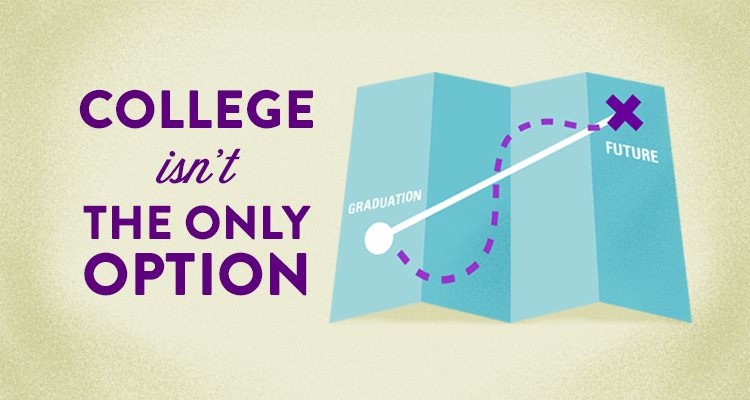Thinking about what to do after high school can be scary. We all know that additional education and training beyond high school are valuable. Attending a traditional four-year college right after high school may not be the best fit for some students. In fact, a recent report from ACT suggests many high school graduates simply aren’t ready.
What’s more, some students simply want a different path or might be drawn to the market demand for careers that do not require a four year degree, such as the skilled trades.
Clearly, college isn’t the only option for high school graduates. There are a number of excellent alternatives to consider:
Volunteer or community service is a great way to learn more about yourself and explore an interest or passion more deeply. Through service students can meet new people and gain new skills while helping others. Students can volunteer locally or get involved in a national program like AmeriCorps with opportunities to travel the country. VolunteerMatch provides volunteer information and listings in your local community. AmeriCorp is a national program that engages more than 80,000 Americans in intensive service each year. Upon successful completion of a term of service, members are eligible to receive a Segal AmeriCorp Education Award, which may be used only to pay for college. Peace Corps volunteers travel overseas to make differences in the lives of many people in need.
Military service can be a good option if it’s the right fit. Each branch has its own recruiting practices. Military service can provide an education and career path for students who want to serve their country and offers considerable benefits. Students can gain leadership experience, develop practical skills, and save for college. The military provides significant structure and guidance that may be a great benefit to some students. Joining the military requires careful consideration. Talk this option over carefully with family and recruiters. It’s a serious commitment but one with unique benefits. Learn more about joining the military at Today’s Military – and explore your options at My Future.
Apprenticeship programs are great for teens that prefer hands-on learning and know what career they want. Apprenticeships provide valuable work experience and result in specialized training and a career at the completion of a program. The program involves a combination of on-the-job training (OJT) and related classroom instruction under the supervision of a journey-level craft person or trade professional. Workers learn the practical and academic aspects of a highly skilled occupation and, with a registered apprenticeship program, students also earn a paycheck. There are approximately 25,000 registered apprenticeship programs in the U.S. that can be found on the U.S. Department of Labor Office of Apprenticeship website.
Trade Schools, also known as vocational schools, are privately-owned schools specializing in trades or vocations. Trade Schools provide a hands-on-learning experience and practical career skills needed to prepare for a specific career. Most programs take one to two years to complete and result in a certificate or license for a specific career. You can learn a special skill such as welding, mechanics, cosmetology, medical assistance or computer technology. While most vocational schools are accredited, not all of the credits earned can be transferred to other vocational schools or colleges. There are thousands of programs in the U.S. explore through the Department of Education.
Community College provides many options and benefits. It can be a path to a four-year university or provide vocational training and licensure similar to that of a trade school or apprenticeship program. Community colleges are two-year public and private institutions that specialize in college transfer programs, vocational programs, or both. Earning an associate’s degree at a community college will take at least two years for students attending full time. Some community college degrees may take less than two years to complete. If community college was not part of your original plans you might want to take a second look. Taking a few classes to improve an academic record can be a good option for some students before transferring to a four-year university.
Identifying your education preferences, personal interests, and long term career goals are the first step for a teen considering their post high school plans. It’s also important to consider short term needs. For example, the desire to travel, gain hands-on experience or the need to further explore career opportunities may be valuable for some high school graduates. Become knowledgeable about the necessary preparation for a particular field of interest. Finally, explore the range of training and education options that best fit personal goals and preferences.
Great infographic: How to Choose Post-Secondary Education
http://www.graphs.net/201212/education-infographics.html/how-to-choose-post-secondary-education



























































































